Impact of Self-Fabricated Graphene–Metal Oxide Composite Anodes on Metal Degradation and Energy Generation via a Microbial Fuel Cell
Abstract
1. Introduction
2. Methodology Details
2.1. Material and Reagent
2.2. Preparation and Synthesis of Oil Palm Biomass-Derived GO
2.3. GO-ZnO Composites Preparation via Solvothermal Method
2.4. Material Characterizations
2.5. Fabrications of Self-Fabricated Anodes
2.6. Organic Substrate, Inoculation, Assembly and Operation of Microbial Fuel Cell
2.7. Analytical Measurements
2.8. Biological Characterizations and Parameter Optimizations
3. Results and Discussion
3.1. Synthesized Material Analysis
3.2. Energy Generation Analytical Measurement Studies
3.3. Durability Study of GO and GO-ZnO Electrode
3.4. Degradation and Biological Studies
3.5. Oxidation of Food Waste
3.6. Assessment of Food Waste as an Organic Substrate
4. Comparative Profile with Pervious Literature
Present Challenges and Future Perfectives
5. Conclusions
Supplementary Materials
Author Contributions
Funding
Institutional Review Board Statement
Informed Consent Statement
Data Availability Statement
Acknowledgments
Conflicts of Interest
References
- Heilmann, J.; Logan, B.E. Production of electricity from proteins using a microbial fuel cell. Water Environ. Res. 2006, 78, 531–537. [Google Scholar] [CrossRef] [PubMed]
- Logan, B.E.; Regan, J.M. Microbial fuel cells—Challenges and applications. Environ. Sci. Technol. 2006, 40, 5172–5180. [Google Scholar] [CrossRef]
- Khatoon, A.; Mohd Setapar, S.H.; Parveen, T.; Rafatullah, M. Outlook on the role of microbial fuel cells in remediation of environmental pollutants with electricity generation. Catalysts 2020, 10, 819. [Google Scholar]
- Parkhey, P.; Sahu, R. Microfluidic microbial fuel cells: Recent advancements and future prospects. Int. J. Hydrogen Energy 2021, 46, 3105–3123. [Google Scholar] [CrossRef]
- Choudhury, P.; Ray, R.N.; Bandyopadhyay, T.K.; Basak, B.; Muthuraj, M.; Bhunia, B. Process engineering for stable power recovery from dairy wastewater using microbial fuel cell. Int. J. Hydrogen Energy 2021, 46, 3171–3182. [Google Scholar] [CrossRef]
- Ahmad, H.; Parveen, T.; Ahmad, A.; Oves, M.; Ismail, I.M.; Qari, H.A. Recent advances in metal decorated nanomaterials and their various biological applications: A review. Front. Chem. 2020, 8, 341. [Google Scholar]
- Kirubaharan, C.J.; Yoo, D.J.; Kim, A.R. Graphene/poly (3, 4-ethylenedioxythiophene)/Fe3O4 nanocomposite–An efficient oxygen reduction catalyst for the continuous electricity production from wastewater treatment microbial fuel cells. Int. J. Hydrogen Energy 2016, 41, 13208–13219. [Google Scholar]
- Kirubaharan, C.J.; Kumar, G.G.; Sha, C.; Zhou, D.; Yang, H.; Nahm, K.S.; Raj, B.S.; Zhang, Y.; Yong, Y.-C. Facile fabrication of Au@ polyaniline core-shell nanocomposite as efficient anodic catalyst for microbial fuel cells. Electrochim. Acta 2019, 328, 135136. [Google Scholar] [CrossRef]
- Han, D.; Wu, S.; Zhang, S.; Deng, Y.; Cui, C.; Zhang, L.; Long, Y.; Li, H.; Tao, Y.; Weng, Z. A Corrosion-Resistant and Dendrite-Free Zinc Metal Anode in Aqueous Systems. Small 2020, 16, 2001736. [Google Scholar] [CrossRef]
- Rodríguez-Couto, S. Development and modification of materials to build cost-effective anodes for microbial fuel cells (MFCs): An overview. Biochem. Eng. J. 2020, 164, 107779. [Google Scholar]
- Idris, M.O.; Noh, N.A.M.; Yaqoob, A.A. Sustainable microbial fuel cell functionalized with a bio-waste: A feasible route to formaldehyde bioremediation along with bioelectricity generation. Chem. Eng. J. 2022, 1, 140781. [Google Scholar]
- Idris, M.O.; Guerrero-Barajas, C.; Kim, H.-C. Scalability of biomass-derived graphene derivative materials as viable anode electrode for a commercialized microbial fuel cell: A systematic review. Chin. J. Chem. Eng. 2022, in press. [Google Scholar]
- Fu, C.; Zhao, G.; Zhang, H.; Li, S. Evaluation and characterization of reduced graphene oxide nanosheets as anode materials for lithium-ion batteries. Int. J. Electrochem. Sci. 2013, 8, 6269–6280. [Google Scholar]
- Kurra, N.; Jiang, Q.; Nayak, P.; Alshareef, H.N. Laser-derived graphene: A three-dimensional printed graphene electrode and its emerging applications. Nano Today 2019, 24, 81–102. [Google Scholar] [CrossRef]
- Thepsuparungsikul, N.; Ng, T.; Lefebvre, O.; Ng, H. Different types of carbon nanotube-based anodes to improve microbial fuel cell performance. Water Sci. Technol. 2014, 69, 1900–1910. [Google Scholar] [CrossRef] [PubMed]
- Cai, T.; Meng, L.; Chen, G.; Xi, Y.; Jiang, N.; Song, J.; Zheng, S.; Liu, Y.; Zhen, G.; Huang, M. Application of advanced anodes in microbial fuel cells for power generation: A review. Chemosphere 2020, 248, 125985. [Google Scholar] [CrossRef]
- Chiu, W.-T.; Chang, T.-F.M.; Sone, M.; Tixier-Mita, A.; Toshiyoshi, H. Roles of TiO2 in the highly robust Au nanoparticles-TiO2 modified polyaniline electrode towards non-enzymatic sensing of glucose. Talanta 2020, 212, 120780. [Google Scholar] [CrossRef]
- Deng, C.; Ma, C.; Lau, M.L.; Skinner, P.; Liu, Y.; Xu, W.; Zhou, H.; Ren, Y.; Yin, Y.; Williford, B. Amorphous and crystalline TiO2 nanoparticle negative electrodes for sodium-ion batteries. Electrochim. Acta 2019, 321, 134723. [Google Scholar] [CrossRef]
- Baratto, C.; Ferroni, M.; Rocco, D.; De Angelis, C.; Faglia, G. Chemical sensing with ZnO nano and microwires. Nano-M&D 2019, 2019, 28. [Google Scholar]
- Shakeel, N.; Ahamed, M.I.; Kanchi, S.; Kashmery, H.A. Green synthesis of ZnO nanoparticles decorated on polyindole functionalized-Mcnts and used as anode material for enzymatic biofuel cell applications. Sci. Rep. 2020, 10, 5052. [Google Scholar]
- Fadzli, F.S.; Bhawani, S.A.; Adam Mohammad, R.E. Microbial fuel cell: Recent developments in organic substrate use and bacterial electrode interaction. J. Chem. 2021, 2021, 4570388. [Google Scholar] [CrossRef]
- Rafatullah, M.; Chua, Y.S.; Umar, K. Recent advances in anodes for microbial fuel cells: An overview. Materials 2020, 13, 2078. [Google Scholar]
- Ghisellini, P.; Ulgiati, S. Circular economy transition in Italy. Achievements, perspectives and constraints. J. Clean. Prod. 2020, 243, 118360. [Google Scholar] [CrossRef]
- Paulchamy, B.; Arthi, G.; Lignesh, B. A simple approach to stepwise synthesis of graphene oxide nanomaterial. J. Nanomed. Nanotechnol. 2015, 6, 1. [Google Scholar]
- Fahmey, M.S.; El-Aassar, A.-H.M.; Abo-Elfadel, M.M.; Orabi, A.S.; Das, R. Comparative performance evaluations of nanomaterials mixed polysulfone: A scale-up approach through vacuum enhanced direct contact membrane distillation for water desalination. Desalination 2019, 451, 111–116. [Google Scholar] [CrossRef]
- Yaakop, A.S.; Ahmad, A. Application of microbial fuel cells energized by oil palm trunk sap (OPTS) to remove the toxic metal from synthetic wastewater with generation of electricity. Appl. Nanosci. 2021, 11, 1949–1961. [Google Scholar]
- Timmers, R.A.; Strik, D.P.; Hamelers, H.V.; Buisman, C.J. Characterization of the internal resistance of a plant microbial fuel cell. Electrochim. Acta 2012, 72, 165–171. [Google Scholar] [CrossRef]
- Igboamalu, T.E.; Bezuidenhout, N.; Matsena, M.T.; Chirwa, E. Microbial fuel cell power output and growth: Effect of pH on anaerobic microbe consortium. Chem. Eng. Tran. 2019, 76, 1–16. [Google Scholar]
- Katuri, K.P.; Scott, K.; Head, I.M.; Picioreanu, C.; Curtis, T.P. Microbial fuel cells meet with external resistance. Bioresour. Technol. 2011, 102, 2758–2766. [Google Scholar] [CrossRef]
- Yaqoob, A.A.; Yaakop, A.S. Modified graphene oxide anode: A bioinspired waste material for bioremediation of Pb2+ with energy generation through microbial fuel cells. Chem. Eng. J. 2021, 417, 128052. [Google Scholar] [CrossRef]
- Durmus, Z.; Kurt, B.Z.; Durmus, A. Synthesis and characterization of graphene oxide/zinc oxide (GO/ZnO) nanocomposite and its utilization for photocatalytic degradation of basic Fuchsin dye. ChemistrySelect 2019, 4, 271–278. [Google Scholar] [CrossRef]
- Anandhavelu, S.; Thambidurai, S. Single step synthesis of chitin/chitosan-based graphene oxide–ZnO hybrid composites for better electrical conductivity and optical properties. Electrochim. Acta 2013, 90, 194–202. [Google Scholar] [CrossRef]
- Chen, C.-H.; Chung, T.-Y.; Shen, C.-C.; Yu, M.-S.; Tsao, C.-S.; Shi, G.-N.; Huang, C.-C.; Ger, M.-D.; Lee, W.-L. Hydrogen storage performance in palladium-doped graphene/carbon composites. Int. J. Hydrogen Energy 2013, 38, 3681–3688. [Google Scholar] [CrossRef]
- Feng, J.-X.; Zhang, Q.-L.; Wang, A.-J.; Wei, J.; Chen, J.-R.; Feng, J.-J. Caffeine-assisted facile synthesis of platinum@ palladium core-shell nanoparticles supported on reduced graphene oxide with enhanced electrocatalytic activity for methanol oxidation. Electrochim. Acta 2014, 142, 343–350. [Google Scholar] [CrossRef]
- Bikkarolla, S.K.; Cumpson, P.; Joseph, P.; Papakonstantinou, P. Oxygen reduction reaction by electrochemically reduced graphene oxide. Faraday Discuss. 2014, 173, 415–428. [Google Scholar] [CrossRef] [PubMed]
- Li, X.; Sun, P.; Yang, T.; Zhao, J.; Wang, Z.; Wang, W.; Liu, Y.; Lu, G.; Du, Y. Template-free microwave-assisted synthesis of ZnO hollow microspheres and their application in gas sensing. CrystEngComm 2013, 15, 2949–2955. [Google Scholar] [CrossRef]
- Umar, K.; Adnan, R.; Rashid, M. Graphene oxide–ZnO nanocomposite: An efficient visible light photocatalyst for degradation of rhodamine B. Appl. Nanosci. 2021, 11, 1291–1302. [Google Scholar]
- Serrà, A. Self-assembled oil palm biomass-derived modified graphene oxide anode: An efficient medium for energy transportation and bioremediating Cd (II) via microbial fuel cells. Arab. J. Chem. 2021, 14, 103121. [Google Scholar]
- Rodríguez-Couto, S.; Ahmad, A. Preparation, characterization, and application of modified carbonized lignin as an anode for sustainable microbial fuel cell. Process Saf. Environ. Prot. 2021, 155, 49–60. [Google Scholar]
- Yaqoob, S.B.; Bhawani, S.A.; Ismail Abdulrahman, R.M. Utilization of Mangifera indica as Substrate to Bioremediate the Toxic Metals and Generate the Bioenergy through a Single-Chamber Microbial Fuel Cell. J. Chem. 2021, 2021, 8552701. [Google Scholar] [CrossRef]
- Daud, N.N.M. Application of rotten rice as a substrate for bacterial species to generate energy and the removal of toxic metals from wastewater through microbial fuel cells. Environ. Sci. Pollut. Res. 2021, 28, 62816–62827. [Google Scholar] [CrossRef] [PubMed]
- Sajana, T.; Ghangrekar, M.; Mitra, A. Application of sediment microbial fuel cell for in situ reclamation of aquaculture pond water quality. Aquac. Eng. 2013, 57, 101–107. [Google Scholar] [CrossRef]
- Sajana, T.; Ghangrekar, M.; Mitra, A. Effect of presence of cellulose in the freshwater sediment on the performance of sediment microbial fuel cell. Bioresour. Technol. 2014, 155, 84–90. [Google Scholar] [CrossRef] [PubMed]
- Fadzli, F.S.; Rashid, M. Electricity generation and heavy metal remediation by utilizing yam (Dioscorea alata) waste in benthic microbial fuel cells (BMFCs). Biochem. Eng. J. 2021, 172, 108067. [Google Scholar] [CrossRef]
- Senthilkumar, N.; Pannipara, M.; Al-Sehemi, A.G. PEDOT/NiFe2O4 nanocomposites on biochar as a free-standing anode for high-performance and durable microbial fuel cells. New J. Chem. 2019, 43, 7743–7750. [Google Scholar] [CrossRef]
- Gnana Kumar, G.; Kirubaharan, C.J.; Udhayakumar, S.; Karthikeyan, C.; Nahm, K.S. Conductive polymer/graphene supported platinum nanoparticles as anode catalysts for the extended power generation of microbial fuel cells. Ind. Eng. Chem. Res. 2014, 53, 16883–16893. [Google Scholar] [CrossRef]
- Yaakop, A.S.; Rafatullah, M. Utilization of biomass-derived electrodes: A journey toward the high performance of microbial fuel cells. Appl. Water Sci. 2022, 12, 99–112. [Google Scholar]
- Senthilkumar, N.; Aziz, M.A.; Pannipara, M.; Alphonsa, A.T.; Al-Sehemi, A.G.; Balasubramani, A. Waste paper derived three-dimensional carbon aerogel integrated with ceria/nitrogen-doped reduced graphene oxide as freestanding anode for high performance and durable microbial fuel cells. Bioprocess Biosyst. Eng. 2020, 43, 97–109. [Google Scholar] [CrossRef]
- Kim, J.R.; Min, B.; Logan, B.E. Evaluation of procedures to acclimate a microbial fuel cell for electricity production. Appl. Microbiol. Biotechnol. 2005, 68, 23–30. [Google Scholar] [CrossRef]
- Zhao, Y.; Nakanishi, S.; Watanabe, K.; Hashimoto, K. Hydroxylated and aminated polyaniline nanowire networks for improving anode performance in microbial fuel cells. J. Biosci. Bioeng. 2011, 112, 63–66. [Google Scholar] [CrossRef]
- Peng, X.; Yu, H.; Ai, L.; Li, N.; Wang, X. Time behavior and capacitance analysis of nano-Fe3O4 added microbial fuel cells. Bioresour. Technol. 2013, 144, 689–692. [Google Scholar] [CrossRef] [PubMed]
- Scott, K.; Rimbu, G.; Katuri, K.; Prasad, K.; Head, I. Application of modified carbon anodes in microbial fuel cells. Process Saf. Environ. Prot. 2007, 85, 481–488. [Google Scholar] [CrossRef]
- Tsai, H.-Y.; Wu, C.-C.; Lee, C.-Y.; Shih, E.P. Microbial fuel cell performance of multiwall carbon nanotubes on carbon cloth as electrodes. J. Power Sources 2009, 194, 199–205. [Google Scholar] [CrossRef]
- Kirubaharan, C.J.; Santhakumar, K.; Senthilkumar, N.; Jang, J.-H. Nitrogen doped graphene sheets as metal free anode catalysts for the high performance microbial fuel cells. Int. J. Hydrogen Energy 2015, 40, 13061–13070. [Google Scholar] [CrossRef]
- Wang, Y.; Zhao, C.-e.; Sun, D.; Zhang, J.-R.; Zhu, J.-J. A graphene/poly (3, 4-ethylenedioxythiophene) hybrid as an anode for high-performance microbial fuel cells. ChemPlusChem 2013, 78, 823. [Google Scholar] [CrossRef]
- Christwardana, M.; Frattini, D.; Accardo, G.; Yoon, S.P.; Kwon, Y. Effects of methylene blue and methyl red mediators on performance of yeast based microbial fuel cells adopting polyethylenimine coated carbon felt as anode. J. Power Sources 2018, 396, 1–11. [Google Scholar] [CrossRef]
- Singh, S.; Songera, D.S. A review on microbial fuel cell using organic waste as feed. CIBTech J. Biotechnol. 2012, 2, 17–27. [Google Scholar]
- Al-Zaqri, N.; Yaakop, A.S. Potato waste as an effective source of electron generation and bioremediation of pollutant through benthic microbial fuel cell. Sustain. Energy Technol. Assess. 2022, 53, 102560. [Google Scholar]
- Sasaki, D.; Sasaki, K.; Tsuge, Y.; Kondo, A. Less biomass and intracellular glutamate in anodic biofilms lead to efficient electricity generation by microbial fuel cells. Biotechnol. Biofuels 2019, 12, 72. [Google Scholar] [CrossRef]
- Li, M.; Zhou, M.; Tian, X.; Tan, C.; McDaniel, C.T.; Hassett, D.J.; Gu, T. Microbial fuel cell (MFC) power performance improvement through enhanced microbial electrogenicity. Biotechnol. Adv. 2018, 36, 1316–1327. [Google Scholar] [CrossRef]
- Idris, M.O.; Kim, H.C. Exploring the effectiveness of microbial fuel cell for the degradation of organic pollutants coupled with bio-energy generation. Sustain. Energy Technol. Assess. 2022, 52, 102183. [Google Scholar]
- Yaqoob, A.A.; Mohamad Ibrahim, M.N.; Umar, K.; Bhawani, S.A.; Khan, A.; Asiri, A.M.; Khan, M.R.; Azam, M.; AlAmmari, A.M. Cellulose derived graphene/polyaniline nanocomposite anode for energy generation and bioremediation of toxic metals via benthic microbial fuel cells. Polymers 2021, 13, 135. [Google Scholar] [CrossRef] [PubMed]
- Yaqoob, A.A.; Idris, M.O.; Ahmad, A.; Daud, N.N.M.; Ibrahim, M.N.M. Removal of Toxic Metal Ions from Wastewater Through Microbial Fuel Cells. In Microbial Fuel Cells for Environmental Remediation; Springer: Singapore, 2022; pp. 299–325. [Google Scholar]
- Umar, M.F.; Rafatullah, M.; Ibrahim, M.N.M.; Ismail, N. Bioelectricity production and xylene biodegradation through double chamber benthic microbial fuel cells fed with sugarcane waste as a substrate. J. Hazard. Mater. 2021, 419, 126469. [Google Scholar] [CrossRef]
- Huang, L.; Chai, X.; Quan, X.; Logan, B.E.; Chen, G. Reductive dechlorination and mineralization of pentachlorophenol in biocathode microbial fuel cells. Bioresour. Technol. 2012, 111, 167–174. [Google Scholar] [CrossRef] [PubMed]
- Sharma, Y.; Li, B. The variation of power generation with organic substrates in single-chamber microbial fuel cells (SCMFCs). Bioresour. Technol. 2010, 101, 1844–1850. [Google Scholar] [CrossRef] [PubMed]
- Salvin, P.; Ondel, O.; Roos, C.; Robert, F. Energy harvest with mangrove benthic microbial fuel cells. Int. J. Energy Res. 2015, 39, 543–556. [Google Scholar] [CrossRef]
- Fadzli, F.; Yaakop, A. Benthic microbial fuel cells: A sustainable approach for metal remediation and electricity generation from sapodilla waste. Int. J. Environ. Sci. Technol. 2022, 14, 1–14. [Google Scholar]
- Yaqoob, A.A.; Ibrahim, M.N.M.; Guerrero-Barajas, C. Modern trend of anodes in microbial fuel cells (MFCs): An overview. Environ. Technol. Innov. 2021, 23, 101579. [Google Scholar] [CrossRef]
- Serrà, A.; Bhawani, S.A.; Ibrahim, M.N.M.; Khan, A.; Alorfi, H.S.; Asiri, A.M.; Hussein, M.A.; Khan, I.; Umar, K. Utilizing Biomass-Based Graphene Oxide–Polyaniline–Ag Electrodes in Microbial Fuel Cells to Boost Energy Generation and Heavy Metal Removal. Polymers 2022, 14, 845. [Google Scholar]
- Yaqoob, A.A.; Guerrero–Barajas, C.; Umar, K. Local fruit wastes driven benthic microbial fuel cell: A sustainable approach to toxic metal removal and bioelectricity generation. Environ. Sci. Pollut. Res. 2022, 29, 32913–32928. [Google Scholar] [CrossRef]

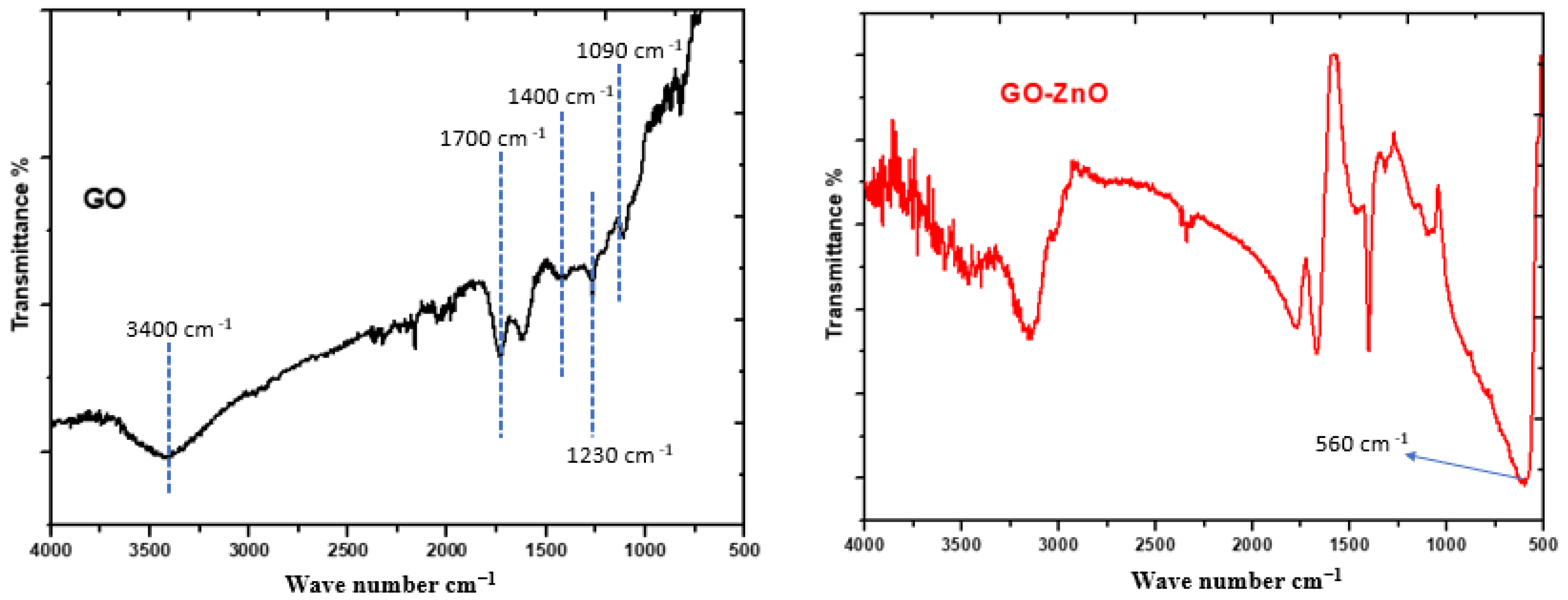


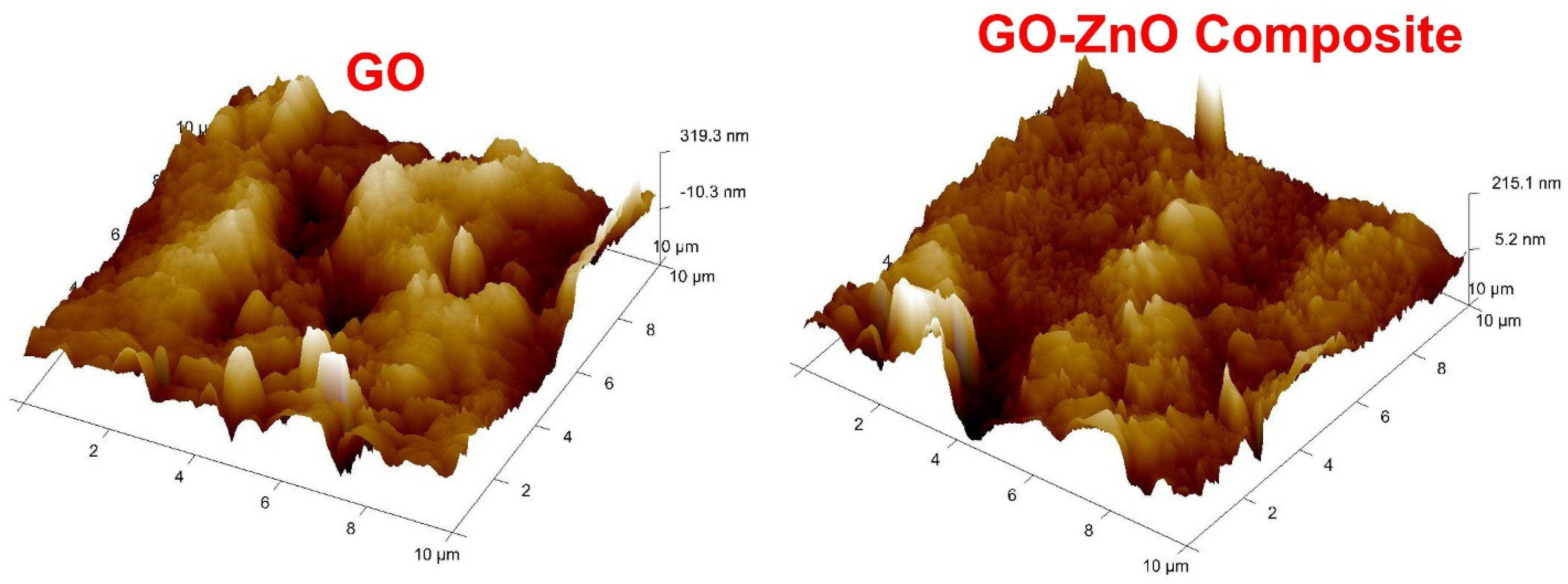
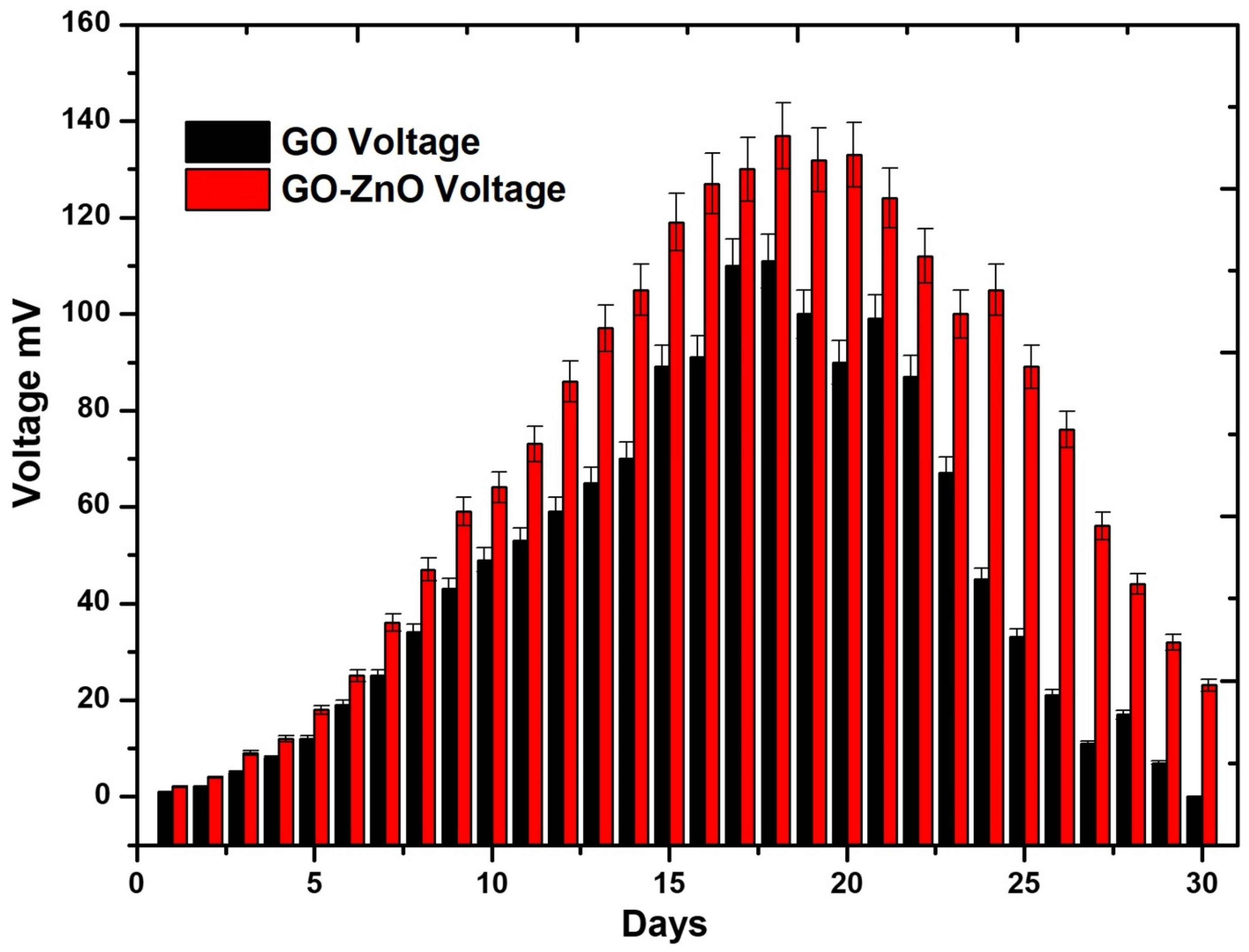

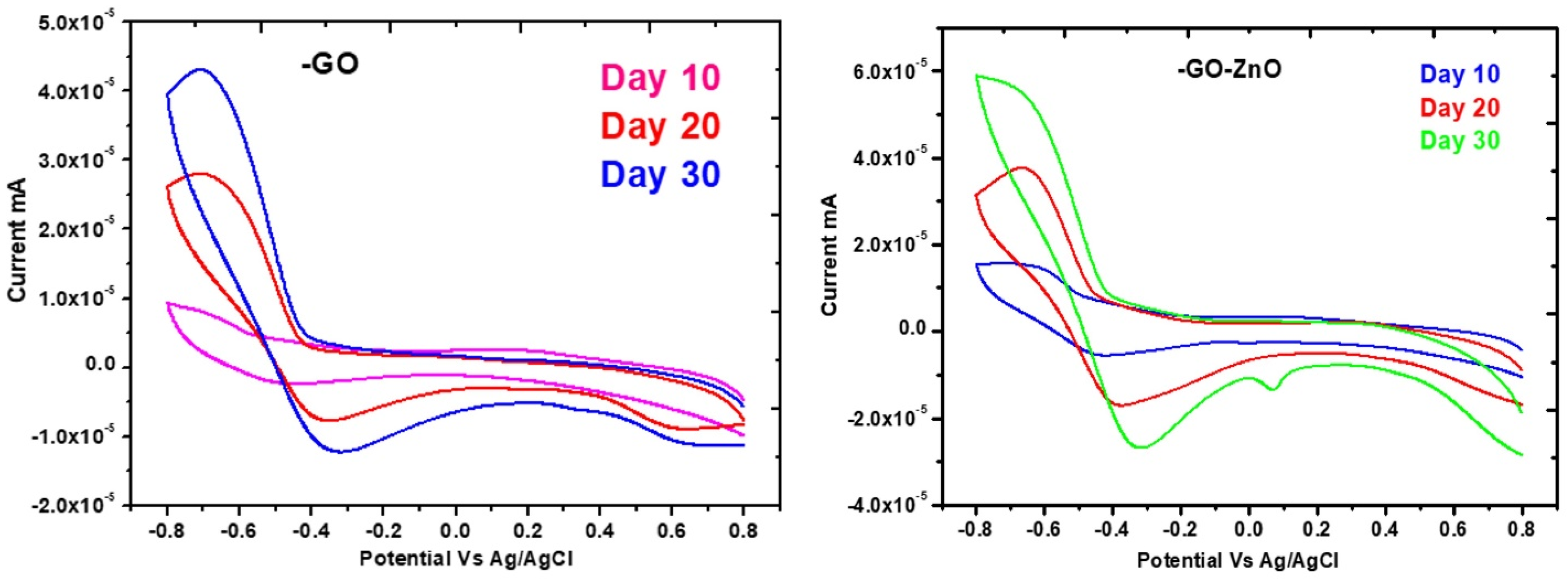
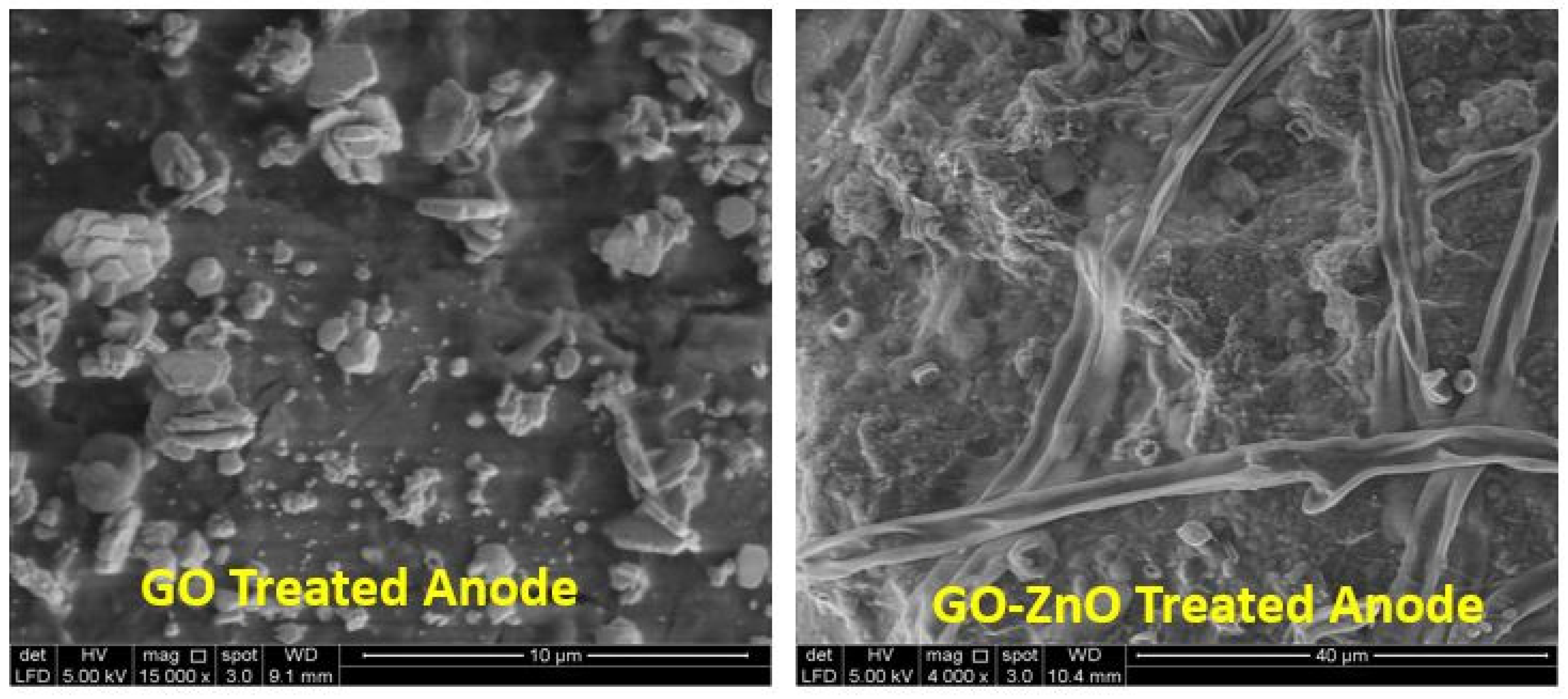

| Parameters | Local Pond Wastewater | Synthetic Wastewater |
|---|---|---|
| pH | 6.97 | 6.40 |
| Color | Light yellow | Light black yellowish |
| Temperature | 24 ± 1 °C | 24 ± 1 °C |
| Metal ions | O mg/L | 10 mg/L |
| Odor | Bad smell | Bad smell |
| Days | Specific Capacitance (F/g) | |
|---|---|---|
| GO | GO-ZnO | |
| 10 | 0.00001 | 0.00004 |
| 20 | 0.00004 | 0.00005 |
| 30 | 0.00006 | 0.00009 |
| Anode Electrode | Inoculation | Durability (Days) | Current Density (mA/m2) | References |
|---|---|---|---|---|
| Fe3O4/Cpe | Mix culture bacteria species | 16.5 | - | [49] |
| Cpe/HAPNWf | Shewanella loihica | 2.1 | 2.90 mA/cm2 | [50] |
| Fe3O4/AC 1/ SSM 2 | Pre-acclimated effluent | 5.0 | 1.90 mA/m2 | [51] |
| AC 1/PANI 3/D-CSA 4/ GF 5 | Mix culture bacteria | 6.2 | 110 mA/m2 | [52] |
| CNT 6/CC 7 | Mix culture bacteria | 8–9 | 65 mA/m2 | [53] |
| NGNS 8 | Escherichia coli | 4.1 | - | [54] |
| Graphene/PEDOT 9/ Cp 10 | Escherichia coli | 24 | 3.59 mA/m2 | [55] |
| PEI 11/GF 12 | Saccharomyces cerevisiae | 5 | - | [56] |
| GO | Mix culture bacteria | 30 | 28.94 mA/m2 | Present study |
| GO-ZnO | Mix culture bacteria | 30 | 38.15789 mA/m2 | Present study |
| Organic Matter | Concentration of Metal Ions | Electrode | Operational Days | Degradation Efficiency (%) | |
|---|---|---|---|---|---|
| Anode | Cathode | ||||
| Food waste | 10 | GO | Graphite rod | 0 | 0.00 |
| 10 | 40.45 | ||||
| 20 | 76.10 | ||||
| 30 | 81.20 | ||||
| GO-ZnO | Graphite rod | 0 | 0.00 | ||
| 10 | 43.89 | ||||
| 20 | 79.04 | ||||
| 30 | 92.71 | ||||
| Electrode | Organic Substrate | Voltage (mV) | Operation Duration (Days) | Degradation Efficiency (%) |
|---|---|---|---|---|
| GO | Glucose | 24 | 10 | 18.00 |
| GO-ZnO | Glucose | 38 | 10 | 31.20 |
| GO | Food waste | 49 | 10 | 40.45 |
| GO-ZnO | Food waste | 64 | 10 | 43.89 |
Disclaimer/Publisher’s Note: The statements, opinions and data contained in all publications are solely those of the individual author(s) and contributor(s) and not of MDPI and/or the editor(s). MDPI and/or the editor(s) disclaim responsibility for any injury to people or property resulting from any ideas, methods, instructions or products referred to in the content. |
© 2023 by the authors. Licensee MDPI, Basel, Switzerland. This article is an open access article distributed under the terms and conditions of the Creative Commons Attribution (CC BY) license (https://creativecommons.org/licenses/by/4.0/).
Share and Cite
Ahmad, A.; Alshammari, M.B.; Ibrahim, M.N.M. Impact of Self-Fabricated Graphene–Metal Oxide Composite Anodes on Metal Degradation and Energy Generation via a Microbial Fuel Cell. Processes 2023, 11, 163. https://doi.org/10.3390/pr11010163
Ahmad A, Alshammari MB, Ibrahim MNM. Impact of Self-Fabricated Graphene–Metal Oxide Composite Anodes on Metal Degradation and Energy Generation via a Microbial Fuel Cell. Processes. 2023; 11(1):163. https://doi.org/10.3390/pr11010163
Chicago/Turabian StyleAhmad, Akil, Mohammed B. Alshammari, and Mohamad Nasir Mohamad Ibrahim. 2023. "Impact of Self-Fabricated Graphene–Metal Oxide Composite Anodes on Metal Degradation and Energy Generation via a Microbial Fuel Cell" Processes 11, no. 1: 163. https://doi.org/10.3390/pr11010163
APA StyleAhmad, A., Alshammari, M. B., & Ibrahim, M. N. M. (2023). Impact of Self-Fabricated Graphene–Metal Oxide Composite Anodes on Metal Degradation and Energy Generation via a Microbial Fuel Cell. Processes, 11(1), 163. https://doi.org/10.3390/pr11010163









